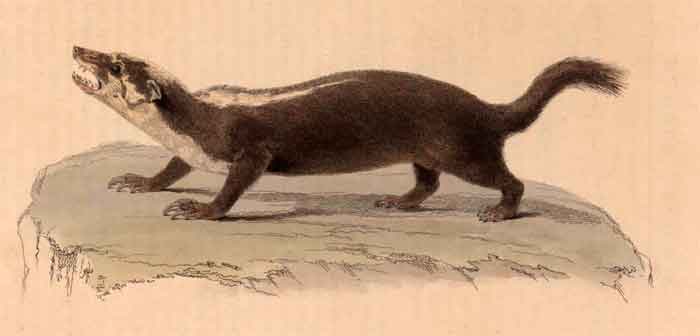
Superregnum: Eukaryota
Cladus: Unikonta
Cladus: Opisthokonta
Cladus: Holozoa
Regnum: Animalia
Subregnum: Eumetazoa
Cladus: Bilateria
Cladus: Nephrozoa
Superphylum: Deuterostomia
Phylum: Chordata
Subphylum: Vertebrata
Infraphylum: Gnathostomata
Megaclassis: Osteichthyes
Cladus: Sarcopterygii
Cladus: Rhipidistia
Cladus: Tetrapodomorpha
Cladus: Eotetrapodiformes
Cladus: Elpistostegalia
Superclassis: Tetrapoda
Cladus: Reptiliomorpha
Cladus: Amniota
Cladus: Synapsida
Cladus: Eupelycosauria
Cladus: Sphenacodontia
Cladus: Sphenacodontoidea
Cladus: Therapsida
Cladus: Theriodontia
Cladus: Cynodontia
Cladus: Eucynodontia
Cladus: Probainognathia
Cladus: Prozostrodontia
Cladus: Mammaliaformes
Classis: Mammalia
Subclassis: Trechnotheria
Infraclassis: Zatheria
Supercohors: Theria
Cohors: Eutheria
Infraclassis: Placentalia
Cladus: Boreoeutheria
Superordo: Laurasiatheria
Cladus: Scrotifera
Cladus: Ferungulata
Cladus: Ferae
Cladus: Pancarnivora
Cladus: Carnivoramorpha
Cladus: Carnivoraformes
Ordo: Carnivora
Subordo: Caniformia
Infraordo: Arctoidea
Superfamilia: Musteloidea
Familia: Mustelidae
Subfamilia: Mustelinae
Genus: Melogale
Species: Melogale orientalis
Subspecies: M. o. orientalis – M. o. sundaicus
Name
Melogale orientalis (Horsfield, 1821)
Type locality: "limited...to...south of Mountain Prahu, between the two prinicpal cones of the central part of Java, the Mountain Sumbing, and...Teggal, ...Baggulen and Banyumas...to Gowong in the east." [Indonesia, Java].
References
Horsfield, T. 1821. Zool. Res. Java.: plate and 4 pages of text.
Melogale orientalis in Mammal Species of the World.
Wilson, Don E. & Reeder, DeeAnn M. (Editors) 2005. Mammal Species of the World – A Taxonomic and Geographic Reference. Third edition. ISBN 0-8018-8221-4.
IUCN: Melogale orientalis (Horsfield, 1821) (Data Deficient)
Melogale orientalis (Horsfield, 1821) – Taxon details on Integrated Taxonomic Information System (ITIS).
Vernacular names
Deutsch: Java-Sonnendachs
English: Javan Ferret-badger
español: Tejón Javanés
The Javan ferret-badger (Melogale orientalis) is a mustelid endemic to Java and Bali, Indonesia.[2] It is listed as Least Concern on the IUCN Red List and occurs from at least 260 to 2,230 m (850 to 7,320 ft) elevation in or close to forested areas.[1]
Description
An adult Javan ferret-badger weighs between 1 and 2 kg (2.2 and 4.4 lb) with a body length of 35 to 40 cm (14 to 16 in) and a tail of 14.5 to 17 cm (6 to 7 in). The head is small with a narrow, blunt snout, long whiskers and large eyes. The body is low-slung with brown silky fur tinged with red and in some lights looks tawny or greyish. The back of the head and throat are darker brown and there are white markings on the face, neck, throat, chest and abdomen.[3]
Distribution and habitat
The Javan ferret-badger is endemic to the islands of Java and Bali in Indonesia. Its exact range is unknown, but it is present in hilly and mountainous areas and may also occur at lower altitudes. In western Java, it has been observed in Mount Halimun Salak National Park and in Gunung Gede Pangrango National Park. In Bali, it has been recorded primary forest on a forest track at an elevation of 1,180 m (3,870 ft) and in an area of secondary forest and rubber plantations not far from human habitations.[1] Javan ferret badgers have been recorded in the wild in just 30 localities in the Province of Banten, West Java, Central Java, Yogyakarta, East Java and on Bali.[4]
Behaviour and ecology
Like other ferret-badgers, the Javan ferret-badger is a fossorial animal that makes use of pre-existing burrows in the forest floor. It is mainly nocturnal, and small groups of adults and juveniles forage together. It is often found in dense undergrowth and it may be able to scramble about in trees and bushes. Its diet is mainly carnivorous and consists of small animals, birds, amphibians, eggs, carrion and invertebrates, and it also eats fruit.[3] Data from litters offered for sale on online platforms suggests a peak in breeding from December to March [4]
In the Gunung Gede Pangrango National Park, Javan ferret-badgers seem fairly common and have been observed scavenging for food scraps after nightfall at picnic areas and turning over the leaf litter. They seemed undisturbed by the presence of humans and one young individual even fed on biscuits held out on an observer's hand.[5]
Threats and conservation
Much of Java's primary forest has been fragmented and degraded. However, the Javan ferret-badger is thought to be at least partially adaptable to habitat changes, as it has been recorded in secondary forests and plantations.[1] Over a ten-year period from 2011 to 2020, Javan ferret badgers were observed offered for sale in eleven wildlife markets on Java and Bali, and on several online platforms.[4]
References
Duckworth, J.W.; Shepherd, C.; Rode-Margono, E.J.; Wilianto, E.; Spaan, D.; Abramov, A.V. (2016). "Melogale orientalis". IUCN Red List of Threatened Species. 2016: e.T41697A45218557. doi:10.2305/IUCN.UK.2016-1.RLTS.T41697A45218557.en. Retrieved 14 November 2021.
Wozencraft, W. C. (2005). "Species Melogale orientalis". In Wilson, D. E.; Reeder, D. M. (eds.). Mammal Species of the World: A Taxonomic and Geographic Reference (3rd ed.). Johns Hopkins University Press. p. 613. ISBN 978-0-8018-8221-0. OCLC 62265494.
Denryter, Kristin (2013). "Melogale orientalis: Javan ferret-badger". Animal Diversity Web. University of Michigan. Retrieved 2014-06-14.
Thomas, Eilish M.; Nekaris, K. Anne-Isola; Imron, Muhammad Ali; Cassey, Phillip; Shepherd, Chris R.; Nijman, Vincent (2021). "Shifts of trade in Javan ferret badgers Melogale orientalis from wildlife markets to online platforms: implications for conservation policy, human health and monitoring". Endangered Species Research. 46: 67–78. doi:10.3354/esr01142. S2CID 238029305.
Duckworth, J.; Roberton, S.; Brickle, N. (2008). "Further notes on Javan ferret badger Melogale orientalis at Gunung Gede Pangrango National Park, Java" (PDF). Small Carnivore Conservation. 39: 39–40. Archived from the original (PDF) on 2015-04-28.
Retrieved from "http://en.wikipedia.org/"
All text is available under the terms of the GNU Free Documentation License

